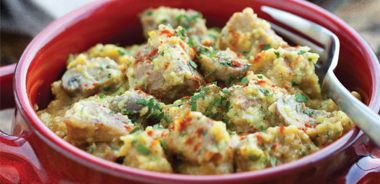Catalonian-Style Seitan Stew with Lemon, Saffron, and Almonds

This seitan stew is a sumptuous vegetarian take on an old Catalonian/Spanish dish. It utilizes a traditional Catalonian sauce component—the picada-—which consists of breadcrumbs, almonds, garlic, and sometimes parsley and other seasonings. This cooking technique and the ingredients can be traced back to the Moorish occupation of Spain.
16 oz (450 g) seitan, drained well and cut into 1 in (2.5 cm) chunks
1/4 cup (60 mL) whole wheat pastry flour
3 Tbsp (45 mL) extra-virgin olive oil, divided
1 cup (250 mL) low-sodium chicken-style vegetarian broth
1 cup (250 mL) fruity dry white wine such as dry Riesling, Chablis, Chardonnay, or Sauvignon Blanc; can also be a nonalcoholic variety
1 pinch of Spanish saffron
Zest of 1 medium lemon
2 tsp (10 mL) unbleached sugar
8 medium mushrooms, quartered
1/4 cup (60 mL) panko or dry breadcrumbs
1/4 cup (60 mL) blanched, slivered almonds
3 or 4 garlic cloves, sliced
1/4 cup (60 mL) chopped parsley
Salt and freshly ground black pepper to taste
Sweet Spanish paprika or sweet smoked paprika for garnish
In shallow bowl or baking pan, toss seitan chunks with flour to coat.
In 12 in (30 cm) heavy skillet, heat 2 Tbsp (30 mL) olive oil over medium-high heat. Add floured seitan chunks and brown them on all sides. Remove from skillet and set aside.
Pour broth and wine into same skillet and bring to a boil. Whisk in saffron, lemon zest, and sugar. Add browned seitan chunks and mushrooms and bring to a simmer. Cover and turn heat to low.
In smaller heavy skillet, heat remaining 1 Tbsp (15 mL) olive oil over medium heat. Add breadcrumbs, almonds, and garlic. Stir mixture constantly until it begins to turn golden. Scrape mixture into food processor. Process cooked breadcrumb mixture to a paste in food processor.
Add breadcrumb mixture to large skillet containing seitan mixture. Turn heat to medium-high and stir gently as it comes to a simmer. Lower heat to a low simmer and cook covered for about 15 minutes. If sauce is too thick for your taste, add a little water or vegetarian broth. Stir in parsley and salt and pepper to taste.
Serve stew, each serving sprinkled with paprika, with crusty bread or steamed long-grain brown rice.
Serves 4.
Each serving contains: 470 calories; 27 g protein; 16 g total fat (2 g sat. fat, 0 trans fat); 50 g carbohydrates; 7 g fibre; 300 mg sodium
source: "Seitan", alive #358, September 2012




